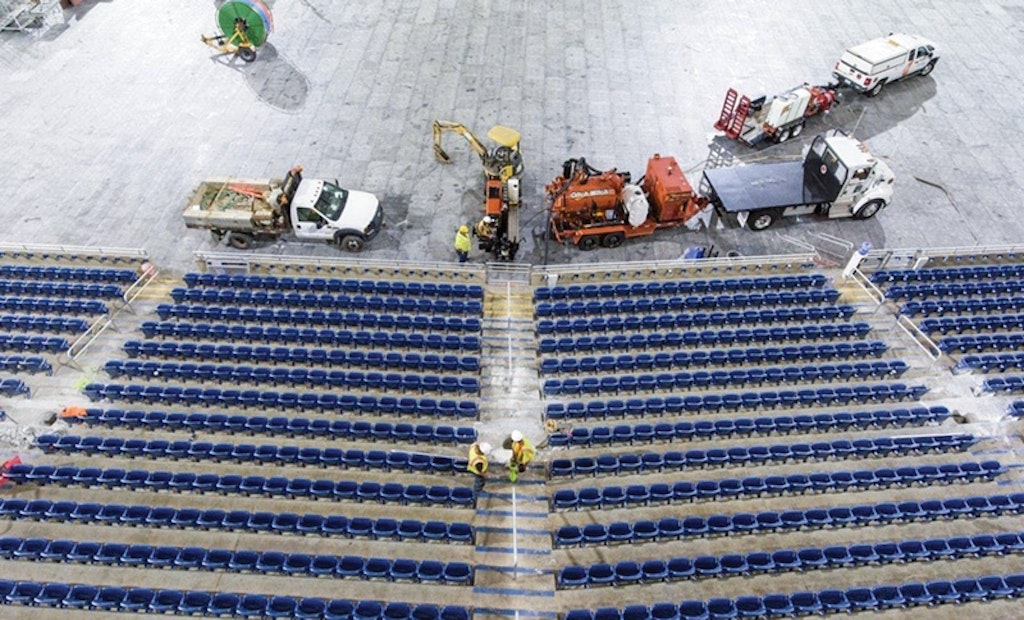
Interested in Municipal/Industrial?
Get Municipal/Industrial articles, news and videos right in your inbox! Sign up now.
Municipal/Industrial + Get AlertsWhen a stadium is packed with thousands of fans using cellphones and two football teams using wireless devices all at the same time, reliable Wi-Fi is a must.
At Ford Field in Detroit, Michigan, the service needed an upgrade. The Detroit Lions organization and Wi-Fi carrier Verizon went to work on the system just as the 2016 season was starting.
“We broke ground Sept. 19 with a compressed schedule to get the boring done in between a couple of football games,” says Shawn Johnson, project manager for KLA Laboratories, the primary contractor.
Crews from KLA and a subcontractor, Underground Contractors (UCI), wrapped up the first phase at the end of September, using directional drills and vacuum excavators. “It wasn’t your typical job,” says Kevin Mecum, supervisor at UCI. “I’ve been doing directional drilling for a long time and I’ve never done anything like what this job required from the machines. It was crazy.”
Only two options
Heading into the job, crews had to put on their thinking caps. There is no access to the seating area from below because it wasn’t built with a basement level.
The Cat6 lines were connected to Wi-Fi access points in handrails in the seating area. “We had to figure out how to get the Cat6 lines from field level, under the seats and up to the handrails,” Johnson says. “Directional boring was really the only option.”
Crews had rejected cutting into the stairways with saws to get piping for the Cat6 lines into the desired locations as too costly, time-consuming and impractical.
Pushing the drills
Crews were on a short time schedule and needed the holes for the Cat6 lines drilled within two weeks, working around the home football games. “Having the directional drills here was mission-critical to getting done on time,” Johnson says.
Krueger Concrete Cutting of Novi, Michigan, started by drilling the holes for the directional drill to enter. The holes were drilled into the brick façade surrounding the field. Once those were completed, UCI came in with its Ditch Witch JT9 Model directional drills. “The ground there in downtown Detroit is clay, so we knew we would get some pretty good steer out of the machines as soon as we got the bore going,” says Mecum.
Directional drills aren’t typically used to bore straight up right after starting a bore, but that is what this job required. “The machines are something else. It’s amazing what you can do with them,” Mecum says. “I’ve done a lot of things, but I’ve never been inside a building trying to bore straight up right away.”
Running into rock
Unfortunately for crews, the clay ground didn’t last.
In the construction of the stadium, some of the clay near the tunnels was excavated and gravel was put in its place. “That was very difficult,” Mecum says. “We struggled to get those shots in. Anybody would have struggled. It was a pea-gravel type of material.”
For most of the job, crews accomplished about five shots a day.
“That was until we got to the rock,” Mecum says. “I had one foreman in the rock and the other was still in the clay. The foreman in the clay was just knocking out the shots, while the other one wasn’t and I could tell he was getting frustrated. I switched them to keep them from getting too stressed out. You have to do that for your crews.”
Finishing the project
UCI began the job with two crews but added more crews as the job progressed. With two of its directional drill crews already at work and the tight time constraints, Mecum brought in another subcontractor, National Fiber, with a directional drill crew. As the three crews finished a bore, two more UCI crews were right behind them backfilling with stone and prepping for concrete.
Crews finished with 39 total bore shots, the longest being 140 feet.
“I think we got out of there a day before our deadline,” Mecum says. “Bringing in that sub helped because it kept us ahead of schedule.”
After all the bores were completed, KLA Laboratories ran the Cat6 lines and new switches to the Wi-Fi access points mounted in enclosures on the handrails. “There are three enclosures in every stairway on the lower level, two in every stairway on the second level, and then on the third level there is a different-style antennae because that coverage will be coming from above,” Johnson says.
The project was completed by the last week of December, in time for the Lions’ final home regular season game of the year against NFC North Division rival Green Bay Packers.
“No one really knew what to expect with this job at first,” Johnson says. “We had confidence in our subcontractors that they could make it happen for us and with us.”






